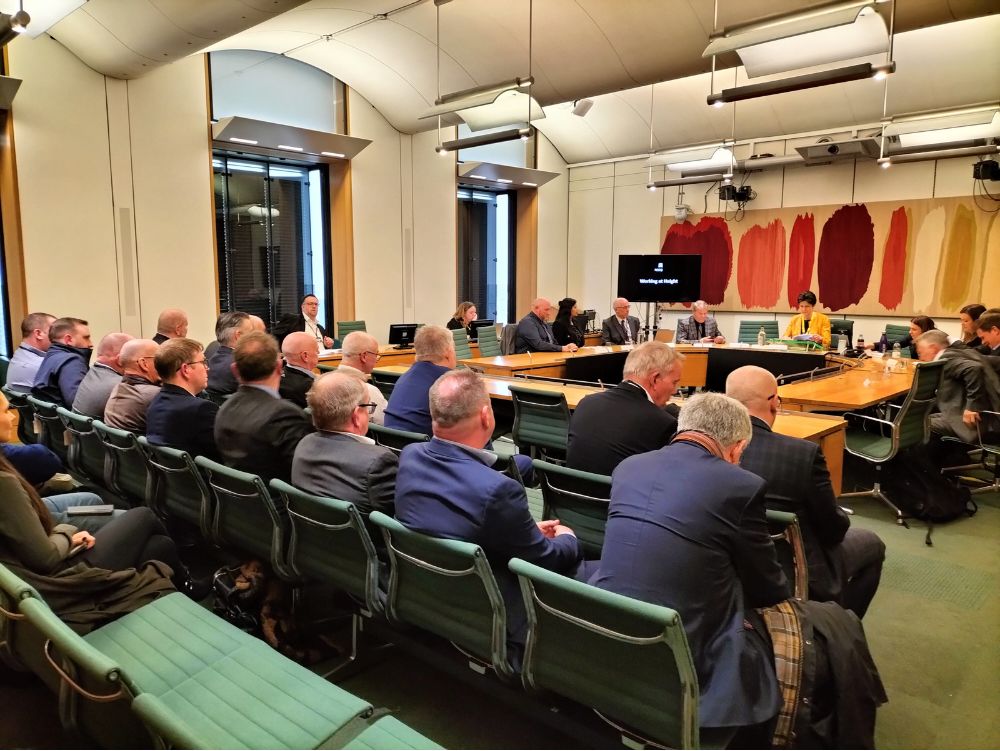As we recently reported, the AIF joined members of Parliament, other trade bodies and industry leaders in Westminster last month to discuss the impact of the Work at Height Regulations being repealed.
AIF Chair Peter Bennett OBE, spoke on behalf of AIF members, telling attendees that we’re seeking a categorical assurance that the regulations won’t be repealed. Here’s his speech in full:
—–
“Good evening, Mme Chair, thank you for facilitating this meeting of the APPG for Working at Height. It’s a pleasure, as always, to see you in the Chair confident in the knowledge that the proceedings are in your capable hands once again. It has been a very long time since we last had an “in person” meeting of the APPG.
The Retained EU Law (Revocation and Reform) Bill, sometimes referred to as REUL or by some more cynically as the “Bonfire Bill”, which is currently at the Report Stage in the House of Lords provides that, unless the Secretary of State intervenes to prevent it, almost 4,000 pieces of EU derived legislation could cease to be on 31 December, including a veritable raft of secondary health & safety regulations.
In a speech in the House of Commons on 22 September 2022, Jacob Rees-Mogg MP said, “The time is now right to bring the special status of retained EU law in the UK statute book to an end on 31 December 2023, in order to fully realise the opportunities of Brexit and to support the unique culture of innovation in the UK.”
He then went on to say “The Bill will sunset the majority of retained EU law so that it expires on 31 December 2023. All retained EU law contained in domestic secondary legislation and retained direct EU legislation will expire on this date, unless otherwise preserved.”
In an article published recently (7 March 2023) in SHP (Safety & Health Practitioner) Online it was reported that a poll of 2,000 UK business owners run by Unchecked UK and supported by RoSPA (the Royal Society for the Prevention of Accidents), showed that health and safety remains a priority, with just seven per cent saying they are willing to accept lower standards. I am advised by my colleagues in ECA (Electrical Contractors’ Association) a poll of their members showed similar results.
Similarly, on 21 March 2023, the same publication reports that “It is noteworthy that both the CBI, IOD and other employers’ groups as well as the TUC and trade union groups have opposed the changes particularly due to the disruptive effects and the number of changes that would need to be assimilated.” and concludes “It would seem unlikely that, if Government ministers are correctly informed, that they would wish to take such a decision in the face of the opposition not only of Trade Unions and specialists but also of influential groups such as the CBI and IOD representing businesses that would be “freed” from such regulation.”
I am very much aware that there are concerns about the sunsetting of other legislation and we will no doubt hear further from others on this in due course, but the AIF, the No Falls Foundation and the APPG for Working at Height are rightly focussed primarily on the Work at Height Regulations.
The government estimated that 1 million companies and 10 million workers carry out work involving some form of working at height every year[1]. That’s a lot of people working at height, and that’s a lot of people at risk of falling from height.
The purpose of the Work at Height Regulations is to prevent death and injury as a result of a fall from a height. Falls at height have historically been and remain one of the biggest causes of workplace fatalities and serious injuries.
Implementing the Work at Height Regulations marked a major change because, for the first time, legislation acknowledged that working at height is a daily occurrence in virtually every industry sector.
Although the Work at Height Regulations were enacted in the UK as a result of the ratification of the Temporary Working at Height Directive (2001/45/EC), firstly, the UK was very much at the forefront in setting the agenda of its framework and, secondly, the UK has regulated work at height for a considerable time, reflected in the earlier
- Construction (Working Places) Regulations 1966 and
- Construction (Health, Safety and Welfare) Regulations 1996
This earlier legislation identified working at height as primarily a construction activity, the WAHR brought welcome clarity that anyone working at height is at risk from a fall.
The effectiveness of the Work at Height Regulations in reducing fatalities is indisputable. In 2004, the year before the implementation of the Work at Height Regulations, 67 fatalities following a fall from height were recorded. Since then, the statistics record a significant reduction in fatalities to less than half that amount in 2021/22 at 29.
Although we at the AIF and the No Falls Foundation contend that the regulations are proving effective, the numbers of fatalities are sadly still too high despite working at height being regulated. There have been 683 families that have lost a loved one even in the 17 years that the Work at Height Regulations have been providing protection. That is enough to fill a Boeing 747-8.
What’s perhaps less often talked about is the consequences of a fall from height for the so-called lucky ones. Survivors are unlikely to return to their previous occupation, if they can return to work at all. There are emotional costs for the family, colleagues and anyone who witnessed the fall.
Compared to some other reportable injuries, falls from height are more likely to result in life-changing injuries. Fall survivors will continue to place demands on our health service and a significant burden on our welfare system for decades (often many) to come. At, on average, 8% of all non-fatal injuries per annum, injuries from falls from height add significant cumulative demand to society; in the last ten years alone, falls from height have amounted to over 54,000 non-fatal injuries. To put that into perspective, that’s enough to fill Anfield Stadium.
It’s difficult to envisage a workplace without the certainty and focus of the Work at Height at Regulations, especially when you consider the cost to Britain now while the activity is regulated.
The UK is a world-leader in prevention of falls from height and consistently shows one of the lowest rates of fatal injury in Europe.[2] Our technological expertise to improve the safety and efficiency of working at height in the construction and building sectors are internationally recognised. This presents an opportunity for the UK to export this experience and superior know-how internationally.
It is our contention that, rather than removing regulations we should be applying efforts to improve working at height. It is our view that any action which would seek to remove or dilute Work at Height Regulations would inevitably lead to a more unsafe environment for those working at height, higher incidence of fatalities and increased costs to the UK economy through increased healthcare and benefit support to those affected by the life-changing consequences of falls from height.
There are many who contend that this Bill is simply a tidy up of regulations post-Brexit and we need fear nothing. In fact, there are some who contend that our shining a light on the Retained EU Law (Revocation and Reform) Bill is tantamount to scaremongering.
Don’t misunderstand me, we have had “reassurances” from MPs and Ministers. Indeed, Mims Davies MP, Minister with responsibility for the Health & Safety Executive in response to an enquiry from the Rt Hon Grant Shapps MP, then Secretary of State for Business, Energy & Industrial Strategy stated “During the Brexit process to leave the EU, the Government made a commitment to protect workers’ rights in matters of health and safety in the workplace. Our standards of health and safety protections are among the highest in the world and there is no reason for that to change.”
Some may say there you go, proof if proof were needed, but it is significant that she says “….and there is no reason for that to change.” She doesn’t say it won’t change! I suppose that we should be thankful that, at least, it’s not a definitive yes, we intend to sunset.
It should be noted that it is for the Secretary of State alone to determine whether to retain, review or revoke any and all of these Regulations. There is no requirement for him to consult with anyone and, of course, he could do the easiest thing of all, do nothing and the regulations automatically sunset anyway.
Mme Chair, we have yet to receive a categorical assurance that these regulations will not be sunsetted, and we would be derelict in our moral and ethical duty if we allowed ourselves to sleepwalk to sunset on 31 December relying on such vague assurances.
We urge the Secretary of State, The Rt Hon Mel Stride MP, to clarify the intentions of the Government unequivocally, particularly in respect of the Work at Height Regulations and their assimilation into UK legislation, but also in respect of the health and safety regulatory framework in general.”
[1] https://www.gov.uk/government/news/overhaul-of-guidance-to-help-10-million-working-at-height
[2] Health and Safety Statistics in the United Kingdom compared with European countries, 2021

If you haven’t already, please write to your MP and ask them to press the Government to safeguard the Work at Height Regulations.
Read more about the repeal risk here












